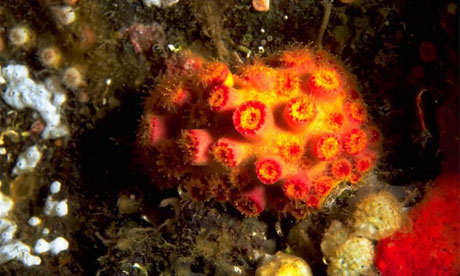· Increased CO2 levels to blame, say experts
· Catastrophic impact on marine ecology predicted
- The Guardian,
- Friday May 23 2008

Floreana coral, which is listed as critically endangered. Photograph: Paul Humann/PA
Scientists conducting a major survey of the North American Pacific coast have found significant increases in acidity that could have a profound effect on sealife.
Rising ocean acidity has been predicted by scientists as a consequence of increased CO2 emissions, but the new research suggests that in some parts of the ocean these increases are happening much faster than predicted. The change seen in the surveys was not expected until 2050.
Experts predict that the changes could have a catastrophic effect on marine life. More acidic seawater means that species such as shellfish, plankton and coral will have much more difficulty making their shells and hard skeletons. That will seriously reduce the productivity of the entire food chain, changing ocean ecology and leading potentially to drastic reductions in fish stocks.
"It's very worrying," said Dr Carol Turley, at Plymouth Marine Laboratory. "The marine food web is extremely complex so [the effects are] very hard to predict. Whether it will support the kind of food web we are used to seeing and depending on in future is anyone's guess really."
She was an author of a major report from the Royal Society in 2005 on ocean acidification. It predicted that the impact would go beyond marine ecosystems and fisheries. "The socioeconomic effects of ocean acidification could be substantial. Damage to coral reef ecosystems and the fisheries and recreation industries that depend on them could amount to economic losses of many billions of dollars per year," the authors wrote.
The Intergovernmental Panel on Climate Change also flagged up ocean acidification as a problem in its fourth assessment report in 2007. It said that human carbon emissions had already reduced average ocean pH by 0.1 units. By 2100 pH could fall by a further 0.5, equivalent to a tripling of the concentration of hydrogen ions.
Higher greenhouse gas emissions lead to more acid seas because around half the CO2 humans produce is soaked up by the oceans. Here it forms carbonic acid, altering the ocean chemistry and making carbonate ions less available to hard-shelled marine creatures. In the new research, Richard Feeley at the US government agency the National Oceanographic and Atmospheric Administration and his colleagues sampled ocean chemistry along 13 survey lines stretching from central Canada to northern Mexico. They found acidic water much closer to the surface than expected. The results are reported today in the journal Science.
"This upwelling water is going to intermittently - once a year or so - flood in for a number of months into our productive shallow seas," said Turley. This would be corrosive to some marine creatures, she said, in effect dissolving the calcium carbonate in their shells.
That does not mean that species will immediately die, but it does mean they have to use huge amounts of energy just to maintain their shells.
The great concern for scientists is the speed at which the changes are happening. "What it does indicate is that [marine species] may not have time to adapt as we might have hoped for," said Turley.

No comments:
Post a Comment